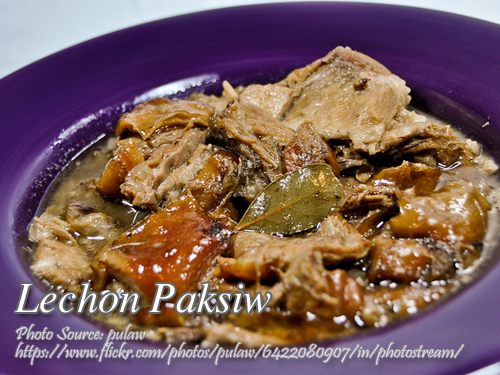Left over lechon can be turned into another delicious dish. So try this lechon paksiw recipe if you have some left over lechon in your fridge. There is also another alternative to pork lechon if it is not available. You can make lechon kawali first by frying large slab of pork. The pork should be boiled first in water with salt until tender. Then deep fry the pork. Chop it into serving pieces and cook it with the ingredients in this recipe.
Lechon Paksiw: A Taste of Home and Heritage
Whenever there’s a family gathering in the Philippines, the centerpiece of the table is often a whole lechon—crispy skin glistening, tender meat underneath, and that irresistible aroma. However, the feast doesn’t end when the party is over. In fact, in my family, that’s when the real magic begins. My Tita Nora, always known for her thriftiness and culinary flair, would say, “Walang masasayang!” She would gather the leftovers and prepare a pot of roasted pork stew, a comforting stew that feels like a warm hug after a night of celebration.
This dish has become a symbol of how Filipinos make the most of what they have, turning something already spectacular into a new experience, one that’s steeped in flavor and nostalgia.
A Nostalgic Twist on Leftovers
In our home, it wasn’t just about reusing leftovers—it was about extending the joy of the previous day’s festivities. I remember watching my Kuya Luis carefully chop the leftover lechon into manageable pieces, reminiscing about the laughter from the night before. While lechon kawali is a great alternative if you don’t have leftover lechon, there’s something uniquely satisfying about transforming that crisp, roasted pork into a rich, savory stew.
Lechon paksiw is not just a dish; it’s a celebration of Filipino resourcefulness. From birthdays to town fiestas, there’s always a reason to make lechon.
Why Vinegar and Liver Sauce Work Wonders
The heart of any good lechon paksiw is its balance of flavors—sour, sweet, salty, and savory. The addition of vinegar isn’t just a nod to traditional Filipino cooking; it’s a practical way to preserve food. My Lola Rosa often explained, “Vinegar keeps the dish longer and cuts through the richness of the pork, giving the stew a tangy brightness that wakes up the palate.”
Liver sauce, or even a can of liver spread, thickens the sauce and adds a deep, earthy flavor. It complements the vinegar and brown sugar, creating a harmony of sweet and savory that clings to every bite of tender pork. If liver sauce isn’t on hand, my cousin Mila swears by liver spread, mixed until it dissolves into the sauce. It’s these little techniques, passed down from one generation to the next, that make every family’s dish unique.
Cooking Techniques That Elevate Lechon Paksiw
One essential technique is simmering the pork long enough for the skin to turn soft and gelatinous. My Tito Ben, a self-taught cook from Batangas, insists on a slow simmer, saying, “Kapag hindi mo pinakuluan ng mabagal, hindi lulusot ang lasa.” This method ensures that every piece of meat absorbs the flavors of garlic, peppercorn, and dried oregano. The slow simmering process also thickens the sauce naturally, giving it that luscious texture without needing extra thickeners.
Patience is key. The longer the stew simmers, the more the flavors meld together, and the more tender the meat becomes.
A Dish Rooted in Filipino History
Lechon paksiw is believed to have originated from the Spanish colonial era, much like many Filipino dishes that blend native and foreign influences. The concept of cooking meat in vinegar traces back to indigenous preservation techniques, while the use of liver sauce and sugar adds a Spanish twist. Over time, Filipinos made the dish their own, incorporating local spices and flavors to suit the Filipino palate.
In many households, the dish isn’t just a meal; it’s a story. A story of celebrations, resourcefulness, and the way food brings people together long after the last guest has left.
A Beginner’s Guide to Perfecting Lechon Paksiw
For those new to Filipino cooking, this is a great dish to start with. Its ingredients are simple, and its techniques are forgiving. Don’t have lechon? Fry up some lechon kawali! Boil a slab of pork belly in salted water until tender, deep fry it until golden and crispy, then proceed with the rest of the recipe. You’ll still get that comforting taste, reminiscent of family gatherings and festive feasts.
Remember, the key is balance. Adjust the vinegar if you prefer a less tangy profile, or add more brown sugar for sweetness. And don’t rush the simmering process—it’s in the waiting that the magic happens.
Food for Thought
Lechon paksiw is more than just a way to use leftovers; it’s a reminder of Filipino ingenuity and love for communal eating. It shows how a dish can evolve from one meal to the next, carrying the joy and memories of family gatherings with every spoonful. So the next time you find yourself with leftover lechon, don’t just reheat it. Transform it, savor it, and let it remind you of the laughter, stories, and love shared around the table.
In our family, every bowl of the dish tells a story. What will yours say?
How to Cook Lechon Paksiw
Ingredients
- 1 kilo cooked lechon
- 1 cup ready-mixed lechon sauce or 1 can liver spread
- 1 cup vinegar
- 1/2 cup brown sugar pack
- 1 Tbsp salt
- 1 Tbsp peppercorn whole
- 4 cloves garlic crushed
- 1 teaspoon MSG (e.g. Vetsin)
- 1/2 cup dried oregano
- 1 cup water
Instructions
How to cook Lechon Paksiw:
- Chop lechon into small serving pieces. Put in pan and add all ingredients (ready-mixed lechon sauce or 1 can liver spread, vinegar, brown sugar, salt, peppercorn, garlic, MSG, dried oregano and water)
- Boil. Lower heat and simmer until lechon skin becomes very soft and sauce thickens.
Notes
Cooking Tips:
Simmer Low and Slow for Tender Meat
To achieve the perfect tenderness, simmer it on low heat for an extended period. This slow cooking process allows the flavors to fully penetrate the meat, making every bite rich and flavorful. Rushing this step can leave the pork tough and the sauce underdeveloped, so patience is key.Balance Vinegar and Sugar for Perfect Flavor
The magic of the dish lies in the delicate balance of sweet and tangy flavors. Start with a small amount of vinegar and brown sugar, then adjust gradually to suit your taste. Too much vinegar can overpower the dish, while too much sugar can make it overly sweet, so aim for harmony in every spoonful.Let the Sauce Thicken Naturally
Allow the sauce to thicken by simmering uncovered, letting the natural reduction intensify the flavors. Avoid adding cornstarch or other thickeners, as the liver sauce and pork fats will naturally create a rich, velvety texture. This method not only enhances the dish's consistency but also deepens the savory notes, making the stew more satisfying.






This recipe is already great without vetsin. Not a fan of vetsin because it makes me sick.
Hi Vangie, yes you can omit the vetsin if you like.
ok tnx natry ko ang recipe mo
Hi Elvis, thanks for visiting and trying the recipe!
i enjoyed cooking your recipe i have done it. my kids loves it. tnx
Hi Sonny, I’m happy to hear that! Thanks for your wonderful comment!